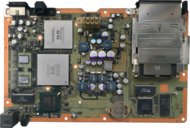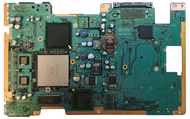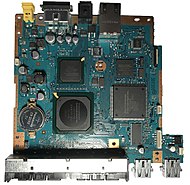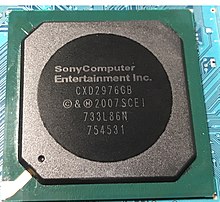




The PlayStation 2 technical specifications describe the various components of the PlayStation 2 (PS2) video game console.





The PlayStation 2 technical specifications describe the various components of the PlayStation 2 (PS2) video game console.
The sixth-generation hardware of the PlayStation 2 video game console consists of various components. At the heart of the console's configuration is its central processing unit (CPU), a custom RISC processor known as the Emotion Engine which operates at 294.912 MHz (299 MHz in later consoles). The CPU heavily relies on its integration with two vector processing units, known as VPU0 and VPU1, the Graphics Synthesizer, and a floating-point unit (FPU) in order to render 3D graphics. Other components, such as the system's DVD-ROM optical drive and DualShock 2 controller, provide the software and user control input.
PlayStation 2 software is distributed on CD-ROM and DVD-ROM. In addition, the console can play audio CDs and DVD movies, and is backwards compatible with original PlayStation games. This is accomplished through the inclusion of the original PlayStation's CPU which also serves as the PS2's I/O processor, clocked at 36.864 MHz in PS2 mode.[1] The PS2 also supports full functionality with the original PlayStation memory cards and controllers. The PS2's DualShock 2 controller is an upgraded version of the PlayStation's DualShock with analog face, shoulder and D-pad buttons replacing the digital buttons of the original.[2] Like its predecessor, the DualShock 2 controller features force feedback technology.
The standard PlayStation 2 memory card has an 8 MB capacity and uses Sony's MagicGate encryption. This requirement prevented the production of memory cards by third parties who did not purchase a MagicGate license. Memory cards without encryption can be used to store PlayStation game saves, but PlayStation games would be unable to read from or write to the card – such a card could only be used as a backup. There are a variety of non-Sony manufactured memory cards available for the PlayStation 2, allowing for a larger memory capacity than the standard 8 MB. However their use is unsupported and compatibility is not guaranteed. These memory cards can have up to 128 MB storage space.
The console also features USB and IEEE 1394 expansion ports. Compatibility with USB and IEEE 1394 devices is dependent on the software supporting the device. For example, the PS2 BIOS will not boot an ISO image from a USB flash drive or operate a USB printer, as the machine's operating system does not include this functionality. By contrast, Gran Turismo 4 and Tourist Trophy are programmed to save screenshots to a USB mass storage device and print images on certain USB printers. A PlayStation 2 HDD can be installed via the expansion bay in the back of the console, and was required to play certain games, notably the popular Final Fantasy XI.[3]




GS effects include: Dot3 bump mapping (normal mapping),[31] [21] mipmapping, spherical harmonic lighting,[32] alpha blending, alpha test, destination alpha test, depth test, scissor test, transparency effects, framebuffer effects, post-processing effects, perspective-correct texture mapping, edge-AAx2 (poly sorting required),[9] bilinear, trilinear texture filtering, multi-pass, palletizing (6:1 ratio 4-bit; 3:1 ratio 8-bit), offscreen drawing, framebuffer mask, flat shading, Gouraud shading, cel shading, dithering, texture swizzling.
^† Standard RGB mode only allows interlaced modes up to 480i (NTSC) and 576i (PAL) and progressive modes up to 240p. A display or adapter capable of sync on green (RGsB) is necessary for higher modes. Furthermore, the PS2's Macrovision copy protection isn't compatible with either RGB mode, and thus DVDs cannot be played with RGB. However, motherboard modifications have been known to bypass these issues.
^†† VGA connector is only available for progressive-scan supported games, homebrew-enabled systems, and Linux for PlayStation 2, and requires a monitor that supports RGsB, or "sync on green" signals.
^††† Contrary to popular belief, the PS2's YPBPR/component output does fully support 240p outputs, including games from the original PlayStation. However, 240p isn't part of the YPBPR standard, and thus not all TVs and HDTVs support it. Upscaling can be used as a workaround.